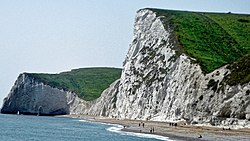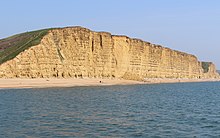Jurassic Coast
| Dorset and East Devon coast | |
|---|---|
|
UNESCO world heritage |
|
|
|
|
| The Coastal Rock as part of the Jurassic Coast |
|
| National territory: |
|
| Type: | nature |
| Criteria : | (viii) |
| Reference No .: | 1029 |
| UNESCO region : | Europe and North America |
| History of enrollment | |
| Enrollment: | 2001 (session 25) |

The Jurassic Coast ( German " Jura coast " ) is a section along the southern English Channel coast. From Orcombe Point , near Exmouth in the county of Devon , in the west to the Old Harry Rocks , near Swanage on the Isle of Purbeck in the county of Dorset , in the east a stretch of coast extends for about 150 km, which in 2001 was the first natural landscape in England to be included in the UNESCO World Heritage List . In addition to the impressive rock and coastal formations, the Jurassic Coast is best known as a fossil site. Large parts are protected as the Area of Outstanding Natural Beauty (“ Area of Outstanding Natural Beauty ”).
geology
Contrary to what its name suggests, the “Jurassic Coast” does not only contain coastal outcrops with deposits from the Jurassic Age. The cliffs between Orcombe Point and the Isle of Purbeck encompass a continuous succession of sedimentary rocks from the Triassic , Jurassic and Cretaceous periods , forming a window to around 185 million years of geological history. The rock strata along the Jurassic Coast are not perfectly horizontal, but tilted slightly to the east. That is why the oldest rocks are found at Orcombe Point in the far west, and towards the east they become increasingly younger.
The oldest rocks in East Devon make up the red coast . Its rocks are made of sandstone that was deposited in the Triassic period 251 to 200 million years ago. At that time the area was a desert landscape . Further east, before the border with Dorset, there are clay and limestone of the Jura, which were formed after the desert was flooded. At the end of the Jurassic period 145 million years ago, the sea level fell and swamps and lagoons formed. 100 million years ago at the turn of the Late Cretaceous, sea levels rose again and an extensive tropical shallow sea covered the region. The approx. 75 million year old Late Cretaceous limestones of the Old Harry Rocks on the Isle of Purbeck are the youngest rocks on the Jurassic Coast.
In addition to the rocky cliffs, the landscape has a number of different coastal forms such as small bays ( Lulworth Cove ), beaches and dune strips ( Chesil Beach ) or the Isle of Portland , an island in the English Channel near Weymouth .
tourism
The Jurassic Coast is a preferred tourist destination because of its scenic beauty. Also popular are hikes along the South West Coast Path , one of the coastal long-distance trails . Points of interest on this trail are geological features such as the fossil forest at Lulworth Cove and the Durdle Door rock bridge as well as various viewpoints. There are museums and visitor centers in the small towns and villages. The Isle of Portland, the fossils in the Charmouth Heritage Coast Center and the quarry caves in Beer are also advertised as special attractions . A central visitor center ( World Heritage Coast Center ) opened in Weymouth in 2011.
Various visitor centers and museums offer information, especially with a local focus. The following history and local museums are promoted by the "World Heritage Site Management":
- Charmouth Heritage Coast Center
- Chesil Beach Center
- Dorset County Museum, Dorchester
- Dorset Wildlife Trust Fine Foundation Marine Center
- Durlston Country Park
- Fairlynch Museum, Budleigh Salterton
- Fine Foundation Center, Beer
- Lulworth Cove Heritage Center
- Philpot Museum, Lyme Regis
- Portland Bill Visitor Center
- Portland Museum
- Quarry Caves, Beer
- Sidmouth Museum
- Studland Visitor Center, Knoll Beach
- Swanage Heritage Center
Gateway Towns
The so-called Gateway Towns offer ideal opportunities to get to the Jurassic Coast. In these places there are also companies and institutions that serve the management and preservation of the world natural heritage. The following cities and towns are considered gateway towns:
- Beer
- Budleigh Salterton
- Charmouth
- Exmouth
- Lyme Regis
- Isle of Portland
- Seaton
- Sidmouth
- Swanage
- Wareham
- Weymouth
Web links
- Official Jurassic Coast website
- The South West Coast Path National Path
- UNESCO site on the Jurassic Coast
- Geological field studies by Ian West, Southampton University
Coordinates: 50 ° 42 ′ 20 ″ N , 2 ° 59 ′ 24 ″ W.





